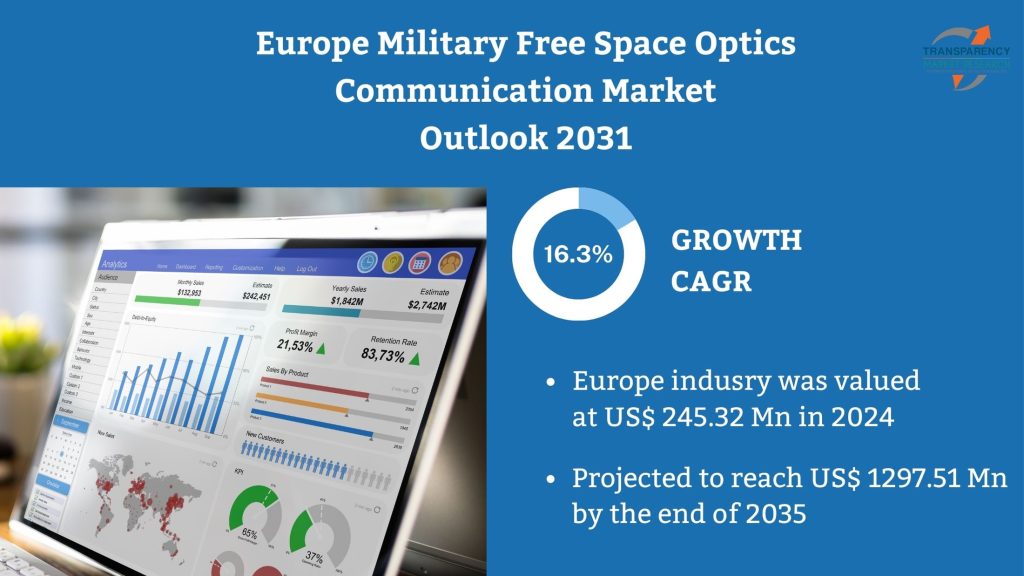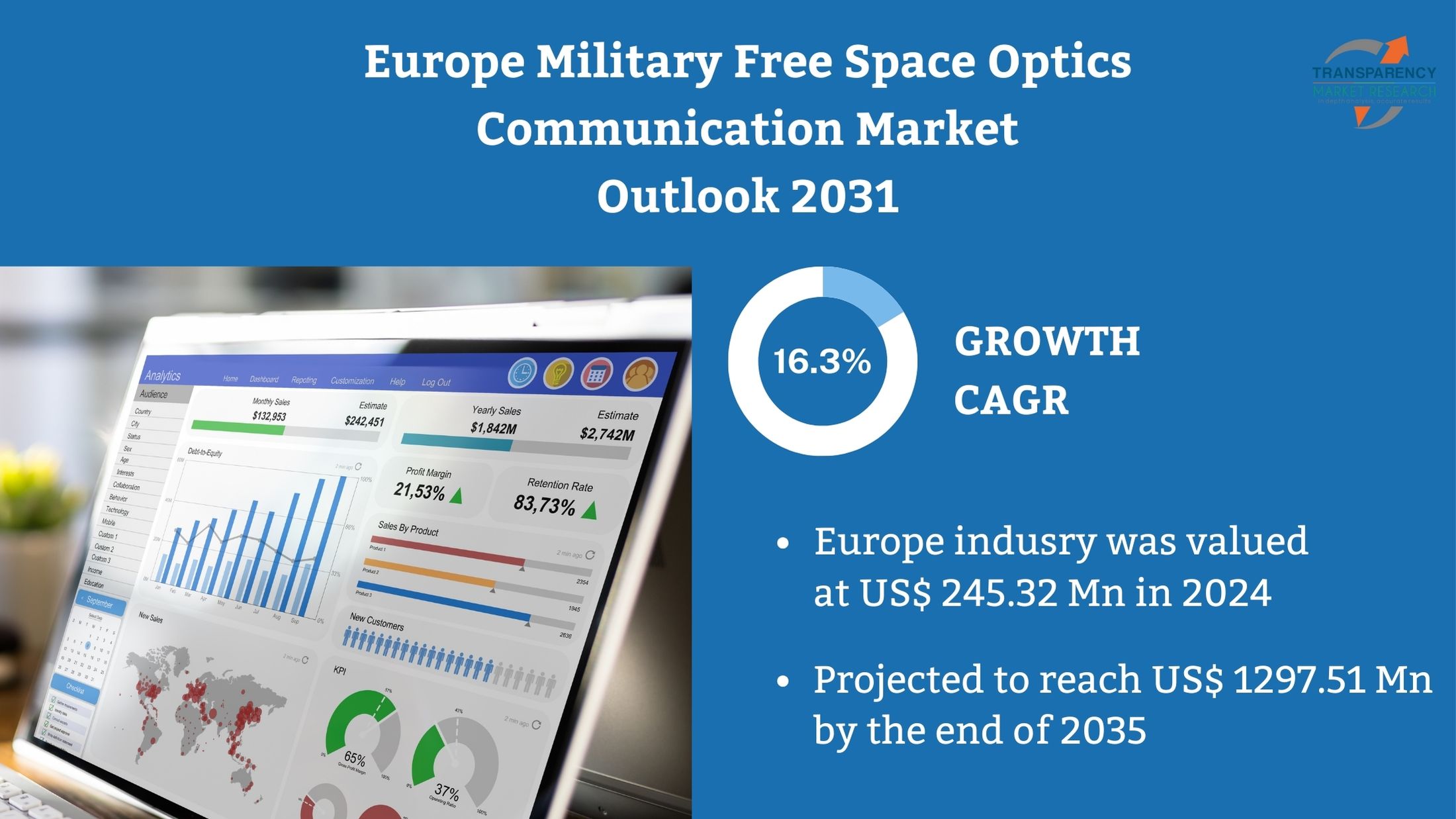
Wilmington, Delaware, Transparency Market Research Inc. –, Feb. 21, 2025 (GLOBE NEWSWIRE) — The Europe Military Free Space Optics Communication industry (Militärische Freiraum-Optik-Kommunikationsindustrie), valued at US$ 245.32 million in 2024, is projected to grow at a CAGR of 16.27% from 2025 to 2035, reaching approximately US$ 1,297.51 million by 2035.
This growth is driven by increasing demand for secure, high-speed communication systems in defense applications, advancements in optical technology, and the rising need for robust communication networks in challenging environments.
For more insights and to request a sample of the market report, visit: https://www.transparencymarketresearch.com/sample/sample.php?flag=S&rep_id=85973

FSO communication channels find applications in various areas such as storage area networks (SAN), outdoor wireless access, wide area network (WAN) bridging, last-mile access, and military communications. The increasing need for high bandwidth and the growing use of FSO in military applications are significant drivers of this market.
The technology’s advantages, including lower infrastructure costs, rapid broadband deployment, increased data transmission speeds, and enhanced connectivity, are expected to fuel market growth during the forecast period. Additionally, the rising demand for secure, high-speed optical communication, personal long-term evolution (LTE) networks, and last-mile connectivity further supports the market’s expansion.
Some of the major players operating in the global free space optics (FSO) communication market are:
- Cailabs
- Coherent Corp.
- FOG Photonics, Inc.
- FSO Instruments
- fSONA
- General Atomics
- Honeywell International Inc.
- JSC Mostcom
- Kratos Defense & Security Solutions, Inc.
- Mitsubishi Electric Corporation
Recent developments of Companies
- Nokia (Finland): In June 2024, Nokia, a Finnish telecom giant, announced its acquisition of Infinera to bolster its optical networking capabilities, including FSO technologies. While not exclusively military-focused, this move accelerates Nokia’s product roadmap, potentially benefiting European defense applications by enhancing secure, high-bandwidth communication systems.
- Mynaric AG (Germany): In 2024, Mynaric, a German company specializing in laser communication, expanded its partnerships with European defense entities. Known for its CONDOR Mk3 terminal, Mynaric has been integrating FSO solutions into military satellite and airborne platforms, aligning with Europe’s push for advanced C4ISR (Command, Control, Communications, Computers, Intelligence, Surveillance, and Reconnaissance) systems.
Report coverage & details:
| Report Coverage | Details |
| Forecast Period | 2025-2035 |
| Base Year | 2024 |
| Market Size in 2024 | USD 245.32 million |
| Market Size in 2035 | USD 1297.51 million |
| CAGR | 16.27% |
| No. of Pages in Report | 384 Pages |
| Segments Covered | by Components, End-User, Type, Platform, |
| Drivers | Rise in adoption of aerospace & military for free-space optics due to its multiple advantages |
| Restraints | Problems encountered due to atmospheric turbulence, bright light, and fog |
Key Insight of the Global Free space optics (FSO) communication Market
- North America will dominate the market during the forecast period.
North America held the largest share of the global FSO communication market in 2023, accounting for 34.5% of market revenue. The region’s dominance is attributed to the presence of prominent research centres and the significant role of well-established industries in fostering the development of FSO communication.
- In 2023, the transmitter segment dominated the market with the largest market share of 18% and revenue of 200.80 million.
The component segment is divided into modulators, transmitters, demodulators, encoders, decoders, and receivers. In 2023, the transmitter segment dominated the market with the largest market share of 18% and revenue of 200.80 million.
- In 2023, the defence segment dominated the market with the largest market share of 12% and revenue of 133.86 million.
The end-user segment is divided into IT & telecommunication, healthcare, traffic, aerospace, military, defence, business, consumer electronics, manufacturing, automotive, and others. In 2023, the defence segment dominated the market with the largest market share of 12% and revenue of 133.86 million.
Get Customized Insights & Analysis for Your Business Needs: https://www.transparencymarketresearch.com/sample/sample.php?flag=S&rep_id=85973
Market Dynamics
Driver: The adoption of FSO in aerospace and military applications.
The adoption of FSO in aerospace and military applications is driven by its ability to overcome common wireless communication challenges, such as bandwidth limitations and slower data transmission speeds. FSO is particularly effective in military and aerospace settings, including deep-space probes, satellite links, remote area communications, unmanned aerial vehicles (UAVs), and aircraft.
It is used for point-to-point communication within a clear line of sight, employing modulation techniques like amplitude and phase modulation to convert input signals into digital signals for transmission.
Restraints: FSO technology faces challenges related to atmospheric conditions.
FSO technology faces challenges related to atmospheric conditions, such as turbulence, bright light, and fog, which can disrupt the transmission of light waves. For instance, the presence of moisture (fog) can significantly impair the light wave’s characteristics through scattering, absorption, and reflection.
Additionally, before installing FSO systems between two endpoints, it is crucial to ensure an unobstructed line of sight, free from obstacles like buildings or trees. These factors hinder the market’s growth.
Opportunities: Technological advancements.
Technological advancements in FSO communication present significant opportunities for the market. FSO technology enables wireless data transmission through modulated optical beams without the need for fiber optics or other optical systems.
The evolution of FSO began with Graham Bell’s photophone, which transmitted voice signals using modulated sunlight. The modern resurgence of FSO systems has been driven by the availability of lasers, which offer improved output power and stability, allowing for precise beam direction over long distances.
Key Segments covered in the market:
- Component
- Transmitters
- Receivers
- Modulators
- Demodulators
- Encoders & Decoders
- Other Components
- Type
- Point to Point
- Point to Multi Point
- Platform
- Ground Based
- Naval
- Airborne
- Space Based
- End-user
- Army
- Tactical Communication
- Mobile Command Centers
- Vehicle-to-Vehicle Communication
- Forward Operating Base (FOB) Connectivity
- Emergency Medical Communications
- Other Army Applications
- Airforce
- Airborne ISR Communication
- UAV Communication
- Command and Control (C2) Operations
- Combat Search and Rescue (CSAR) Missions
- Weather and Intelligence Data Transmission
- Other Airforce Applications
- Navy
- Ship-to-Ship Communication
- Submarine Communications
- Training and Simulation
- Ship-to-Shore Data Transfer
- Other Navy Applications
- Army
- Country
- UK: Led with a 23.6% share in 2022, fueled by advanced defense initiatives.
- Rest of Europe: Includes Germany, France, and others, with varying adoption rates based on military tech investments.
Purchase the Full Market Report Today: https://www.transparencymarketresearch.com/checkout.php?rep_id=85973<ype=S
Frequently Asked Questions
Q1. How big was the Military Free Space Optics Communication market in 2024?
- It was valued at US$ 245.32 Mn in 2024.
Q2. How is the Military Free Space Optics Communication industry expected to grow during the forecast period?
- The CAGR is projected to be 16.27% from 2025 to 2035.
Q3. What are the key factors driving the demand for Military Free Space Optics Communication?
- Growing Demand for Secure Communication & Expansion of Defense Budgets.
Q4. Which segment contributed the largest share of the Military Free Space Optics Communication business in 2024?
- Based on Military Free Space Optics Communication end-user segment, Army segment accounted for major share of 46.63% in 2024.
Q5. Which Country is more attractive for Military Free Space Optics Communication vendors?
- UK is highly attractive for Military Free Space Optics Communication vendors.
Q6. How big was The China in the Military Free Space Optics Communication landscape?
- The China was valued at US$ 49.9 Mn in 2024.
Explore Latest Research Reports by Transparency Market Research:
About Transparency Market Research
Transparency Market Research, a global market research company registered at Wilmington, Delaware, United States, provides custom research and consulting services. Our exclusive blend of quantitative forecasting and trends analysis provides forward-looking insights for thousands of decision makers. Our experienced team of Analysts, Researchers, and Consultants use proprietary data sources and various tools & techniques to gather and analyses information.
Our data repository is continuously updated and revised by a team of research experts, so that it always reflects the latest trends and information. With a broad research and analysis capability, Transparency Market Research employs rigorous primary and secondary research techniques in developing distinctive data sets and research material for business reports.
Contact:
Transparency Market Research Inc.
CORPORATE HEADQUARTER DOWNTOWN,
1000 N. West Street,
Suite 1200, Wilmington, Delaware 19801 USA
Tel: +1-518-618-1030
USA – Canada Toll Free: 866-552-3453
Website: https://www.transparencymarketresearch.com
Email: sales@transparencymarketresearch.com
Follow Us: LinkedIn| Twitter| Blog | YouTube

© 2025 Benzinga.com. Benzinga does not provide investment advice. All rights reserved.


